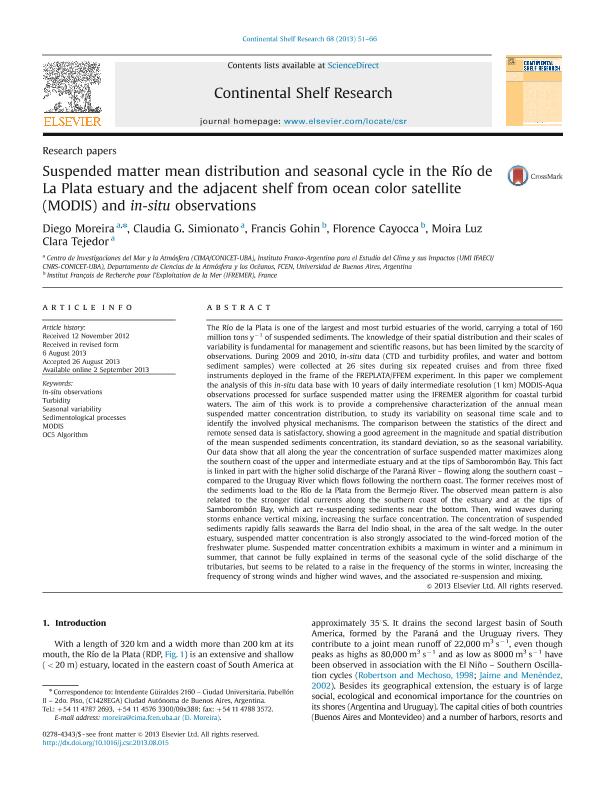Artículo
Suspended matter mean distribution and seasonal cycle in the Río de La Plata estuary and the adjacent shelf from ocean color satellite (MODIS) and in-situ observations
Moreira, Diego; Simionato, Claudia Gloria ; Gohin, Francis; Cayocca, Florence; Luz Clara Tejedor, Moira
; Gohin, Francis; Cayocca, Florence; Luz Clara Tejedor, Moira
 ; Gohin, Francis; Cayocca, Florence; Luz Clara Tejedor, Moira
; Gohin, Francis; Cayocca, Florence; Luz Clara Tejedor, Moira
Fecha de publicación:
10/2013
Editorial:
Pergamon-Elsevier Science Ltd
Revista:
Continental Shelf Research
ISSN:
0278-4343
Idioma:
Inglés
Tipo de recurso:
Artículo publicado
Clasificación temática:
Resumen
The Río de la Plata is one of the largest and most turbid estuaries of the world, carrying a total of 160 million tonsy-1 of suspended sediments. The knowledge of their spatial distribution and their scales of variability is fundamental for management and scientific reasons, but has been limited by the scarcity of observations. During 2009 and 2010, in-situ data (CTD and turbidity profiles, and water and bottom sediment samples) were collected at 26 sites during six repeated cruises and from three fixed instruments deployed in the frame of the FREPLATA/FFEM experiment. In this paper we complement the analysis of this in-situ data base with 10 years of daily intermediate resolution (1km) MODIS-Aqua observations processed for surface suspended matter using the IFREMER algorithm for coastal turbid waters. The aim of this work is to provide a comprehensive characterization of the annual mean suspended matter concentration distribution, to study its variability on seasonal time scale and to identify the involved physical mechanisms. The comparison between the statistics of the direct and remote sensed data is satisfactory, showing a good agreement in the magnitude and spatial distribution of the mean suspended sediments concentration, its standard deviation, so as the seasonal variability. Our data show that all along the year the concentration of surface suspended matter maximizes along the southern coast of the upper and intermediate estuary and at the tips of Samborombón Bay. This fact is linked in part with the higher solid discharge of the Paraná River - flowing along the southern coast - compared to the Uruguay River which flows following the northern coast. The former receives most of the sediments load to the Río de la Plata from the Bermejo River. The observed mean pattern is also related to the stronger tidal currents along the southern coast of the estuary and at the tips of Samborombón Bay, which act re-suspending sediments near the bottom. Then, wind waves during storms enhance vertical mixing, increasing the surface concentration. The concentration of suspended sediments rapidly falls seawards the Barra del Indio shoal, in the area of the salt wedge. In the outer estuary, suspended matter concentration is also strongly associated to the wind-forced motion of the freshwater plume. Suspended matter concentration exhibits a maximum in winter and a minimum in summer, that cannot be fully explained in terms of the seasonal cycle of the solid discharge of the tributaries, but seems to be related to a raise in the frequency of the storms in winter, increasing the frequency of strong winds and higher wind waves, and the associated re-suspension and mixing.
Archivos asociados
Licencia
Identificadores
Colecciones
Articulos(CIMA)
Articulos de CENTRO DE INVESTIGACIONES DEL MAR Y LA ATMOSFERA
Articulos de CENTRO DE INVESTIGACIONES DEL MAR Y LA ATMOSFERA
Citación
Moreira, Diego; Simionato, Claudia Gloria; Gohin, Francis; Cayocca, Florence; Luz Clara Tejedor, Moira; Suspended matter mean distribution and seasonal cycle in the Río de La Plata estuary and the adjacent shelf from ocean color satellite (MODIS) and in-situ observations; Pergamon-Elsevier Science Ltd; Continental Shelf Research; 68; 10-2013; 51-66
Compartir
Altmétricas



